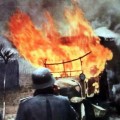Part 3
The Conflict Widens The war of rapid movement ground to a halt, and the two great enemy armies became completely deadlocked along a six-hundred mile front of impregnable trenches. For the next four years there was little change. As attack after attack failed to penetrate the enemy lines the toll in human lives grew rapidly, and the Western Front became an area of bloody stalemate.
Faced with the prospect of a long struggle both sides began an urgent search for allies. The Dominions had already joined Britain and their troops were soon involved in the far-flung operations. The war became more truly a world war as Japan, in 1914, and Italy, in 1915 joined the Entente Powers, while Turkey lined up with Germany and Austria. Other countries were drawn in, one by one, until by 1917 every continent and all the oceans of the world were involved.
Canada Enters the War That Canada was automatically at war when Britain was at war in 1914 was unquestioned as from coast to coast, in a spirit of almost unbelievable unanimity, Canadians pledged support for the Motherland. Sir Wilfred Laurier spoke for the majority of Canadians when he proclaimed: "It is our duty to let Great Britain know and to let the friends and foes of Great Britain know that there is in Canada but one mind and one heart and that all Canadians are behind the Mother Country." Prime Minister Robert Borden, calling for a supreme national effort, offered Canadian assistance to Great Britain. The offer was accepted, and immediately orders were given for the mobilization of an expeditionary force.
With a regular army of only 3,110 men and a fledgling navy, Canada was ill-prepared to enter a world conflict. Yet, from Halifax to Vancouver, thousands of young Canadians hastened to the recruiting offices. Within a few weeks more than thirty-two thousand men gathered at Valcartier Camp near Quebec City; and within two months the First Contingent, Canadian Expeditionary Force, was on its way to England in the largest convoy ever to cross the Atlantic. Also sailing in this convoy was a contingent from the still separate British self governing colony of Newfoundland. A suggestion that Newfoundland's men should be incorporated into the Canadian Expeditionary Force had earlier been politely but firmly rejected. On reaching England the Canadians endured a long miserable winter training in the mud and drizzle of Salisbury Plain. In the spring of 1915 they were deemed ready for the front line and were razor-keen. Nothing, they believed, could be worse than Salisbury. In the years that lay ahead, they were to find out just how tragically wrong that assessment was.
The first Canadian troops to arrive in France were the Princess Patricia's Canadian Light Infantry, which had been formed at the outbreak of war entirely from ex-British army regular soldiers. The "Princess Pats" landed in France in December 1914 with the British 27th Division and saw action near St. Eloi and at Polygon Wood in the Ypres Salient. Today, their battalion memorial stands on the high ground of Bellewaarde Ridge.
Early in February 1915, the 1st Canadian Division reached France and was introduced to trench warfare by veteran British troops. Following this brief training they took over a section of the line in the Armentières sector in French Flanders. Faced with the realities of dirt, disease and death, their illusions of military glory quickly disappeared.

